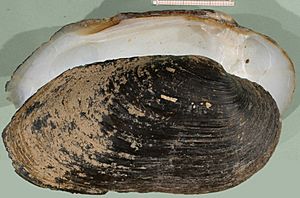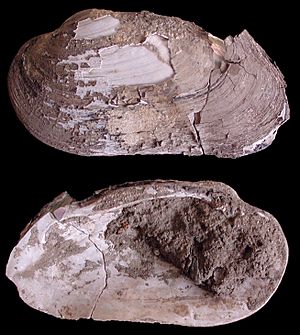Spengler's freshwater mussel facts for kids
Quick facts for kids Spengler's freshwater mussel |
|
|---|---|
 |
|
| A shell of Spengler's freshwater mussel collected by Fritz Haas in Spain | |
| Conservation status | |
| Scientific classification | |
| Genus: |
Margaritifera
|
| Species: |
auricularia
|
| Synonyms | |
|
Unio auricularius Spengler, 1793 |
|
The Spengler's freshwater mussel (scientific name: Margaritifera auricularia) is a type of freshwater mussel found in Europe. It's an aquatic animal, meaning it lives in water. It belongs to a group of animals called bivalves, which have two shells, and it's a kind of mollusk.
This mussel used to live all over western and central Europe. But now, it's critically endangered, which means it's very close to disappearing forever. It's one of the rarest invertebrates (animals without a backbone) in the world. Today, you can only find it in a few rivers in Spain and France.
People often call it Spengler's freshwater mussel. This name honors Lorenz Spengler, the person who first described this species.
Contents
What Does It Look Like?
The shells of Spengler's freshwater mussels can grow quite large. They can be up to 180 millimeters (about 7 inches) long.
How Scientists Name It
Scientists sometimes have different ways of classifying animals. This mussel was first described in 1793 as Unio auricularius.
Today, it is often placed in the genus Margaritifera. When this happens, its scientific name is Margaritifera auricularia.
Sometimes, it is placed in a different genus called Pseudunio. In that case, its name becomes Pseudunio auricularia.
Where It Lives
This mussel is found in several countries. It used to be found in many more places.
Today, you can find it in:
It might also live in some rivers in North Africa, like Morocco.
In other places, it has disappeared:
- Germany – It disappeared from the upper Rhine River after the year 1500.
- Netherlands – It is either extinct or only found as fossils.
- Belgium – It is extinct or only found as fossils.
- Luxembourg – It is extinct or only found as fossils.
- Czech Republic – Only fossil records have been found here. These fossils are from layers where ancient settlements from the Stone Age (Neolithic period) were found.
Life Cycle and Fish Hosts
The Spengler's freshwater mussel has tiny larvae called glochidiums. These larvae need to attach to certain fish for a short time to grow. These fish are called "hosts."
The fish that host the glochidium larvae of this mussel include:
- Salaria fluviatilis (a type of blenny fish)
- Gambusia holbrooki (a mosquitofish)
- Acipenser baerii (Siberian sturgeon)
- Acipenser naccarii (Adriatic sturgeon)
- Acipenser sturio (European sturgeon)
For a long time, scientists did not know which fish were hosts for this mussel. They only discovered this in recent years.
See also
 In Spanish: Náyade auriculada para niños
In Spanish: Náyade auriculada para niños
- Margaritifera laevis



